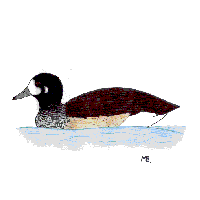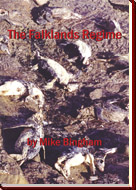 |
 |
|
|
|
|
|
|
|
|
|
|
|
ChiloŽ Wigeon Local Name: Wigeon Breeding Range: Falkland Islands
and South America The ChiloŽ Wigeon is widespread around the Falklands, although not particularly common. It generally inhabits large ponds, rivers, tidal creeks and kelp beds where it feeds on aquatic invertebrates and vegetation. Nests are made of grass and hidden in vegetation, often a long way from the water's edge. Between 5 and 8 eggs are laid between September and December, and chicks leave the nest at an early age. Chicks feed themselves, mostly on small invertebrates, under the watchful eye of the parents. ChiloŽ Wigeon are most common in areas where there are an abundance of suitable ponds, such as in Lafonia, where birds may be found in small flocks. Sexes are similar in appearance. They are easily distinguished from other water fowl by their distinctive plumage. |
|
|
||||||||||||||||||||||||||||



